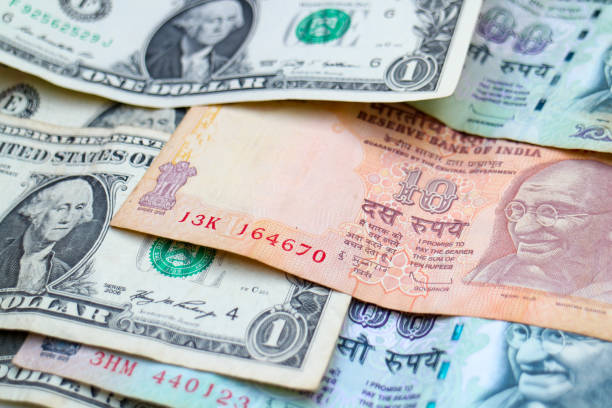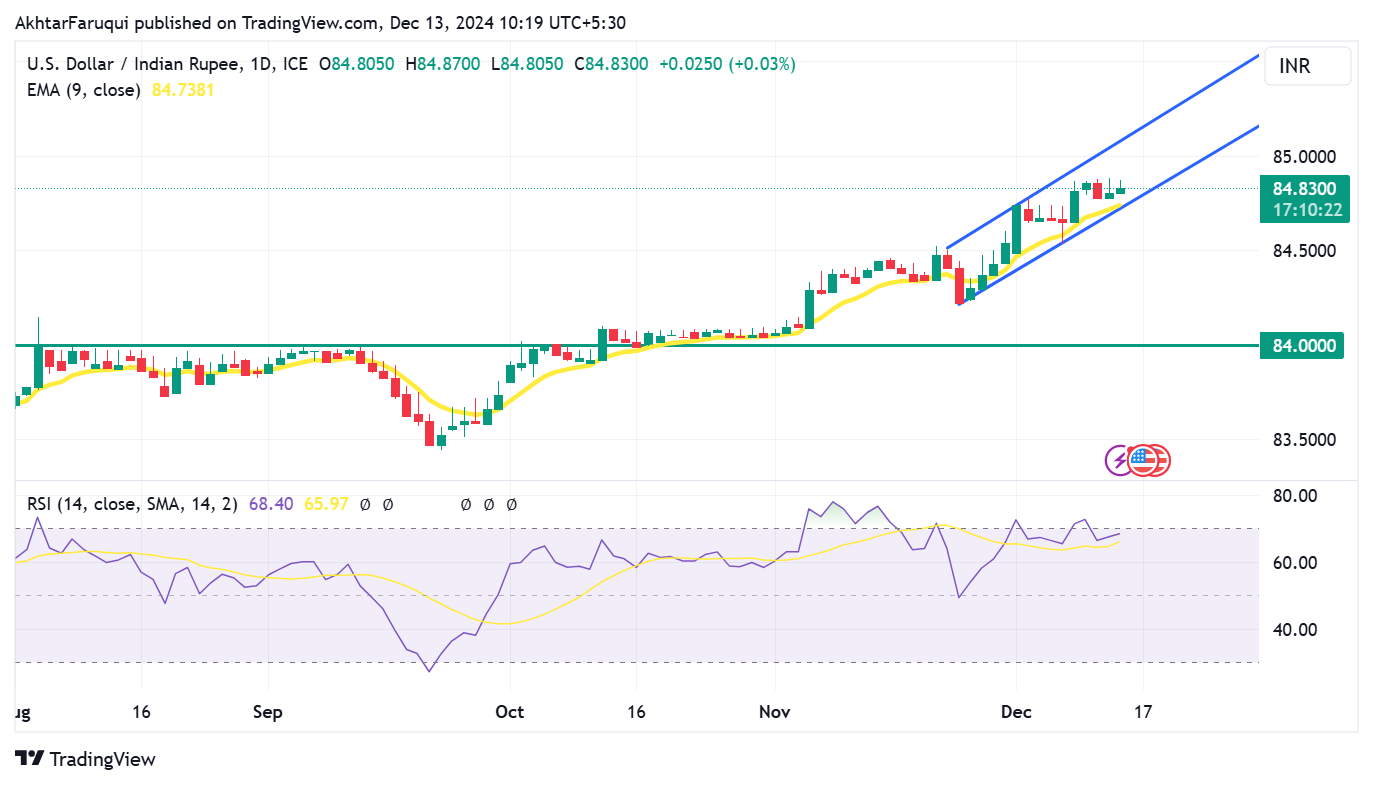USD/INR maintains position near fresh highs due to a stronger US Dollar
- Bitcoin Cash Unveiled: Why Did BCH Price Surpass BTC? Can it Soar to $1,000 in the Future?
- AUD/USD holds steady below 0.6650, highest since September ahead of China's trade data
- After the Crypto Crash, Is an Altcoin Season Looming Post-Liquidation?
- The 2026 Fed Consensus Debate: Not Hassett, It’s About Whether Powell Stays or Goes
- AUD/USD sticks to gains above 0.6600, highest since late October after Aussie trade data
- AUD/USD holds steady above 0.6600; remains close to two-month high ahead of US PCE data

The Indian Rupee remains subdued due to risk aversion amid Trump’s tariff threats.
Asian currencies struggle as offshore Chinese Yuan falls following remarks from a senior trade adviser to US President-elect Trump.
Indian benchmark indices opened lower on Friday, mirroring Wall Street's overnight decline.
The Indian Rupee (INR) extends losses for the second successive session, hovering near fresh record lows on Friday. The upside of the USD/INR pair could be attributed to the stronger US Dollar (USD) amid Trump’s tariff threats.
Asian currencies are under pressure amid a weaker offshore Chinese Yuan (CNH), driven by remarks from a senior trade adviser to US President-elect Donald Trump. The adviser warned China against currency manipulation, according to a Reuters report.
The INR may also face challenges following the appointment of bureaucrat Sanjay Malhotra as the next RBI Governor, which prompts traders to raise their bets on the interest rate cuts. Additionally, India’s retail inflation moderated to 5.48% in November, from October's 14-month high of 6.21%, helped by slowing food prices, boosting expectations of an RBI’s interest rate cut in the February policy review.
The downside of the Indian Rupee might be capped by the foreign exchange intervention by the Reserve Bank of India (RBI). The Indian central bank often intervenes by managing liquidity, including selling USD to prevent steep INR depreciation.
Indian Rupee remains subdued amid foreign fund outflows
Indian benchmark indices, the BSE Sensex and Nifty 50, opened lower on Friday, mirroring Wall Street's overnight decline. Investors in India are expected to remain cautious ahead of the upcoming Federal Reserve's (Fed) Federal Open Market Committee (FOMC) meeting next week.
On December 12, Foreign Institutional Investors (FIIs) recorded net sales of Indian equities worth ₹3,560.01 crore, while Domestic Institutional Investors (DIIs) made net purchases amounting to ₹2,646.65 crore.
Financial markets are now fully pricing in a 25 basis point rate cut by the Federal Reserve on December 18, according to the CME FedWatch Tool.
On Thursday, the US Producer Price Index (PPI) jumped 0.4% MoM in November, the largest gain since June, after an upwardly revised 0.3% increase in October. This reading was better than the 0.2% expected.
US Consumer Price Index (CPI) rose to 2.7% year-over-year in November from 2.6% in October. The headline CPI reported a 0.3% reading MoM, in line with the market consensus. Meanwhile, the core CPI, excluding volatile food and energy prices, climbed 3.3% YoY, while the core CPI increased 0.3% MoM in November, as expected.
S&P Global Ratings on Tuesday estimated 6.8% growth for the Indian economy in FY25, followed by 6.9% growth in FY26, on the back of strong urban consumption, steady service sector growth, and ongoing investment in infrastructure.
Technical Analysis: USD/INR marks fresh highs near 85.00
The Indian Rupee remains subdued near its all-time lows against the US Dollar on Friday. The USD/INR pair trades around 84.80 on Friday, with a technical analysis of the daily chart suggesting a strengthening bullish bias. The pair moves upwards within an ascending channel pattern, with the 14-day Relative Strength Index (RSI) positioning slightly below the 70 level.
The USD/INR pair may attempt to surpass its all-time high of 84.88, recorded on December 12. A breakout above this level could allow the pair to test the upper boundary of the ascending channel, situated near 85.10.
The initial support could be found at the nine-day Exponential Moving Average (EMA) of 84.73 level, which aligns with the lower boundary of the ascending channel near the psychological level of 84.70.
USD/INR: Daily Chart
Indian Rupee FAQs
The Indian Rupee (INR) is one of the most sensitive currencies to external factors. The price of Crude Oil (the country is highly dependent on imported Oil), the value of the US Dollar – most trade is conducted in USD – and the level of foreign investment, are all influential. Direct intervention by the Reserve Bank of India (RBI) in FX markets to keep the exchange rate stable, as well as the level of interest rates set by the RBI, are further major influencing factors on the Rupee.
The Reserve Bank of India (RBI) actively intervenes in forex markets to maintain a stable exchange rate, to help facilitate trade. In addition, the RBI tries to maintain the inflation rate at its 4% target by adjusting interest rates. Higher interest rates usually strengthen the Rupee. This is due to the role of the ‘carry trade’ in which investors borrow in countries with lower interest rates so as to place their money in countries’ offering relatively higher interest rates and profit from the difference.
Macroeconomic factors that influence the value of the Rupee include inflation, interest rates, the economic growth rate (GDP), the balance of trade, and inflows from foreign investment. A higher growth rate can lead to more overseas investment, pushing up demand for the Rupee. A less negative balance of trade will eventually lead to a stronger Rupee. Higher interest rates, especially real rates (interest rates less inflation) are also positive for the Rupee. A risk-on environment can lead to greater inflows of Foreign Direct and Indirect Investment (FDI and FII), which also benefit the Rupee.
Higher inflation, particularly, if it is comparatively higher than India’s peers, is generally negative for the currency as it reflects devaluation through oversupply. Inflation also increases the cost of exports, leading to more Rupees being sold to purchase foreign imports, which is Rupee-negative. At the same time, higher inflation usually leads to the Reserve Bank of India (RBI) raising interest rates and this can be positive for the Rupee, due to increased demand from international investors. The opposite effect is true of lower inflation.
Read more
* The content presented above, whether from a third party or not, is considered as general advice only. This article should not be construed as containing investment advice, investment recommendations, an offer of or solicitation for any transactions in financial instruments.


